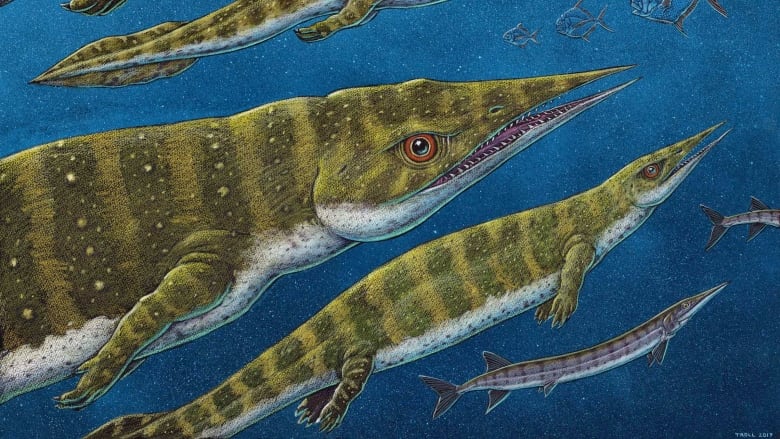@ WFS,World Fossil Society,Riffin T Sajeev,Russel T Sajeev
An articulated Late Triassic (Norian) thalattosauroid from Alaska and ecomorphology and extinction of Thalattosauria

This is an artist’s depiction of Gunakadeit joseeae, a species of the marine reptile thalattosaur previously unknown to science that roamed the coast of what is now Alaska 200 million years ago. (Ray Troll)
An iguana-like creature with a needle-sharp snout has been confirmed from a fossilized skeleton as a species of the marine reptile thalattosaur previously unknown to science that roamed the coast of what is now Alaska some 200 million years ago.

This fossil of Gunakadeit joseeae was found on an island in southeast Alaska. About two thirds of the tail had already eroded away when the fossil was discovered. (Alaska Museum of the North)
Dating from the Triassic period and identified from a lone fossil found in the Tongass National Forest in Alaska, the new creature has been named Gunakadeit joseeae, after a Tlingit name for a legendary sea monster, according to an article published on Tuesday in the journal Scientific Reports.
It is the only intact thalattosaur fossil ever found in North America, said paleontologist Pat Druckenmiller, director of the University of Alaska Museum of the North and lead author of the study.
“This animal is striking because it’s got this super-sharp pointed snout. Literally, it’s needle-like,” Druckenmiller said, describing the creature as “weird.”
The snout and the fine bones in its throat suggest a reptile that dug into cracks in submerged reefs to suck out food, mostly small crustaceans and squid.
Lucky low-tide find
The fossil was uncovered through a stroke of luck, when an extremely low tide in 2011 exposed the typically submerged rock where it was embedded on an island beach as scientists happened to be surveying the area.
Fully separating the fossil from rock took years, said U.S. Forest Service geologist Jim Baichtal, one of the scientists who found the specimen.
Positively identifying it as a new species included a trip by Druckenmiller to China, one of the few places where intact thalattosaurs have been discovered.
That work confirmed what was obvious to those who saw the fossil’s skull and snout in 2011, Druckenmiller said: “We knew right away that it was totally different.”
At the time Gunakadeit joseeae was living, what is now the rugged temperate rainforest of southeast Alaska was a much warmer place — a coastal region only about 10 to 20 degrees north of the equator, Druckenmiller said.
That territory migrated northward, pressing into North America and creating the paleontologically interesting terrain of Alaska’s southeast panhandle.
The newly identified thalattosaur is the latest among several important paleontological discoveries in the Tongass National Forest.
They include the 1996 discovery of a 10,300-year-old human skeleton in a cave in the southern part of the largest U.S. national forest. Those remains, of a young man with a fish-based diet, contributed to knowledge about people who migrated to North America by coastal routes rather than over the Bering Land Bridge.
@ WFS,World Fossil Society,Riffin T Sajeev,Russel T Sajeev



 February 7th, 2020
February 7th, 2020  Riffin
Riffin  Posted in
Posted in  Tags:
Tags: 